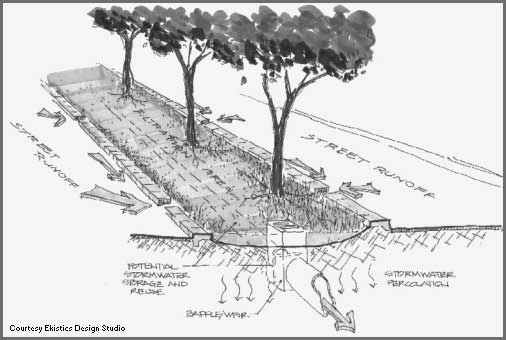
COVERING THE TAMPA BAY AND ITS WATERSHED |
|||||||
|
Putting a LID on Stormwater Runoff Benjamin Franklin nailed it - almost: The only things certain in life are death and taxes - unless you live along the coast, where residential communities spring up out of the ground faster than chinch bugs in July. New development is a fact of life, but site design and development practices can be modified to protect water quality and minimize environmental impacts. Builders and developers already are proving that, and many are profiting from designing landscapes, homes and neighborhoods that complement rather than compete with nature (see Stunning Yards are Florida-Friendly Too). The question is how to encourage and promote better design - and make it easier for developers to jump on the bandwagon. Low Impact Development, a more environmentally sensitive approach to developing land and managing stormwater runoff, may provide some answers. LID is beginning to take off in Maryland and the Chesapeake Bay, and will be the focus of a May 25 meeting at the Tampa Airport Marriott. Co-sponsored by the Tampa Bay Regional Planning Council and Florida Department of Environmental Protection, the workshop will feature LID guru Larry Coffman of Prince Georges County in Maryland. "Because Low Impact Development is a relatively new concept in Florida, the workshop will showcase successful examples of LID projects locally and nationwide, as a way to acquaint stormwater managers and developers with this innovative approach to reducing stormwater runoff - the major source of pollution in Tampa Bay," said Dick Eckenrod, executive director of the Tampa Bay Estuary Program. A major objective of the workshop, says Suzanne Cooper of the Tampa Bay Regional Planning Council, is to identify both economic and environmental benefits of LID, as well as existing barriers to implementation. The meeting also is an opportunity to gauge the interest of local governments and area developers in embracing LID concepts. Engagement is key. Builders for the Bay, a parallel effort in the Chesapeake Bay, may provide a roadmap. The three-year-old partnership was established by the Center for Watershed Protection, the Alliance for the Chesapeake Bay, and the National Association of Home Builders to promote sound development throughout the massive Chesapeake watershed. Last October, the group of 32 stakeholders completed its first design roundtable in Maryland's Harford County, aimed at forging local consensus about regulatory barriers to environmentally sensitive residential and commercial site design in development codes. Participants spent eight months assessing the area's existing subdivision regulations and road codes to identify changes that would reduce impervious cover, protect open space and minimize the negative impact of stormwater runoff from new development. Recommendations included reducing home setback requirements to allow more compact subdivisions, and changes in regulations governing the minimum and maximum size of parking lots to reduce pavement and runoff. Code changes recommended by the roundtable were intended to give developers more flexibility in commercial and residential site design while adhering to overarching environmental principles. Inflexible ordinances that establish large setbacks and larger-than-needed parking lots and road widths can contribute to sprawl and increase runoff from impervious surfaces. Tampa Bay organizers hope to spark a similar initiative here. Says Tom Levin, president of Ekistics Design Studio in Tampa: "We have the opportunity to make big improvements that take us beyond current mandates. If we can empower developers with incentives to design smarter, we've got a powerful mechanism to reduce runoff to the bay. "And let's not forget the significant bonus: Environmentally sensitive site design has the potential to create communities that are more attractive, livable and valuable."
|
|||||||
|
|||||||
|
© 2004 Bay Soundings
|
|||||||
|
|||||||
